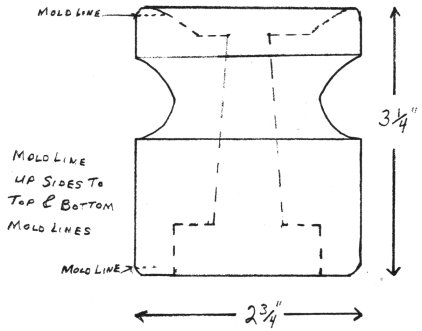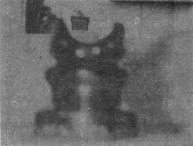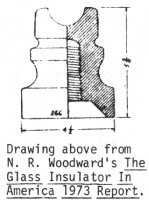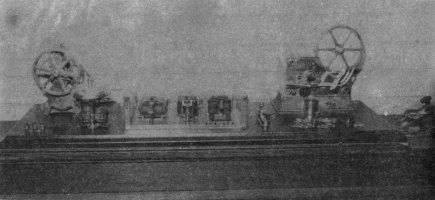Research Division
Reprinted from "INSULATORS - Crown Jewels of the Wire", December 1974, page 29
Dear Dora,
Below is a drawing of a large glass knob I bought today. It is of dark green
aqua glass, with no markings. It is quite heavy (1 lb. 4-1/2 oz.) and has a
threadless pin hole which tapers to the top. These were found on old internal
wiring in a nearby industrial plant. Would appreciate any information you or
your readers might have. Sincerely yours,
Jim Woods

- - - - - - - - -
Well, Jim, there's not much I can tell you about your glass insulating or
break knob, except that it seems every old catalogue I've seen on insulators
seems to carry them in all shapes and sizes. Some have tapered threadless holes,
while others have straight up and down threadless holes. The majority of break
knobs seem to be made by either Brookfield or Hemingray, some embossed, some
not. We don't seem to find very many out here on the West Coast as in other
parts of the country.
Dear Dora;
I have an aqua glass Hemingray No. 4 C.D.# 124 that can find nothing at all
about. The exact embossing is:
| FRONT |
BACK |
BACK (CROWN) |
| A |
4 |
|
| HEMINGRAY |
PATENT |
PAT DEC 19 1871 |
| No 4 |
May 2 1893 |
|
Any available information would be appreciated.
Thank you,
Jim Trabert
- - - - - - - - - -
I found your Hemi No. 4 listed in Milholland's 3rd Revision on page 83. It is
listed in his 1974 Suggested Insulator Price List from $5.00 in poor condition
to $20.00 in mint condition. Francis Terrill's book, Hemingray Insulators
Priced, lists this insulator on page 16 and prices it at $15.00. Both books call
it a "National Pony". There are many variations of embossings.
Dora

Dear Dora:
Enclosed find picture of a mint CD 266. This is a fantastic insulator that
enhances Larry's collection. Hope you like seeing it. It is embossed: PAT JUNE
17, 1890.
Mary Beth Veneziano
West Chicago, Illinois
- - - - - - - - - - -

Editor's Note:
Well, it looks like at least two of the elusive CD 266's have shown up. One
in Illinois, and one on the West Coast. There's a full scale photo of it on page
257 of Milholland's new 3rd Revision Most About Glass Insulators.
Dear Dora,
We have a Brookfield miniature in light aqua with the following embossing:
|
FRONT |
|
BACK |
|
BROOKFIELD |
|
STANDARD |
| (DOME) |
WESTERN |
(DOME) |
ELEC. CO. |
It is 1" wide and 1-1/4" tall.
I think I remember reading something about the miniature a couple of years
back, about its history, etc., but cannot find it. Could you give me some info
on it? The one in Milholland's 3rd Revision is described as "clear"
and is embossed only "BROOKFIELD". Would appreciate any help that you
could give.
Sincerely,
Elton & Lynda Gish
- - - - - - - - -
Dear Readers,
I need help with this one! Is anyone familiar with this miniature?
Your
Editor
Here are some pictures of a type of glass block insulator I acquired from a
bottle collector recently. It is smaller than any of the other blocks I've seen,
measuring 2-1/2 inches long by 1-1/4 inches wide. Also, the wire groove is
straight in stead of notched. The block is flanged at each end and is light aqua
in color. Any information will be appreciated.

Above is a picture of a fire alarm telegraph machine from the Atlanta Fire
Department. It is made of brass, with the clockwork mechanisms encased in glass.
Three telegraph sounders are in the glass box in the middle. Base is slate and
wood. The namesplates (2) read:
"The Gamewell Co." Patents;
| #633,982.Oct. 3, 1899. |
|
|
No. 1272 |
| #691,587.Jan. 21, 1902. |
|
and
"The Gamewell F. A, Tel. Co.
New York"
I would like to hear from anyone knowing something about the glass block.
Thanks.
Ben Kelley
College Park, Georgia
| 